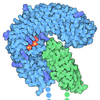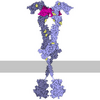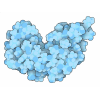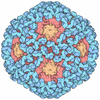+ Open data
Open data
- Basic information
Basic information
| Entry | Database: PDB / ID: 7y1r | ||||||
|---|---|---|---|---|---|---|---|
| Title | Human L-TGF-beta1 in complex with the anchor protein LRRC33 | ||||||
 Components Components | (Transforming growth factor ...) x 2 | ||||||
 Keywords Keywords | SIGNALING PROTEIN / NRROS / anchor protein | ||||||
| Function / homology |  Function and homology information Function and homology informationsequestering of TGFbeta in extracellular matrix / cellular response to acetaldehyde / frontal suture morphogenesis / Influenza Virus Induced Apoptosis / adaptive immune response based on somatic recombination of immune receptors built from immunoglobulin superfamily domains / positive regulation of microglia differentiation / regulation of interleukin-23 production / branch elongation involved in mammary gland duct branching / positive regulation of primary miRNA processing / columnar/cuboidal epithelial cell maturation ...sequestering of TGFbeta in extracellular matrix / cellular response to acetaldehyde / frontal suture morphogenesis / Influenza Virus Induced Apoptosis / adaptive immune response based on somatic recombination of immune receptors built from immunoglobulin superfamily domains / positive regulation of microglia differentiation / regulation of interleukin-23 production / branch elongation involved in mammary gland duct branching / positive regulation of primary miRNA processing / columnar/cuboidal epithelial cell maturation / negative regulation of skeletal muscle tissue development / embryonic liver development / macrophage derived foam cell differentiation / response to laminar fluid shear stress / regulation of enamel mineralization / regulation of branching involved in mammary gland duct morphogenesis / regulation of cartilage development / TGFBR2 MSI Frameshift Mutants in Cancer / regulation of striated muscle tissue development / regulation of blood vessel remodeling / regulation of protein import into nucleus / regulatory T cell differentiation / tolerance induction to self antigen / extracellular matrix assembly / negative regulation of natural killer cell mediated cytotoxicity directed against tumor cell target / negative regulation of hyaluronan biosynthetic process / type III transforming growth factor beta receptor binding / myofibroblast differentiation / positive regulation of cardiac muscle cell differentiation / positive regulation of odontogenesis / connective tissue replacement involved in inflammatory response wound healing / Langerhans cell differentiation / TGFBR2 Kinase Domain Mutants in Cancer / positive regulation of smooth muscle cell differentiation / positive regulation of exit from mitosis / negative regulation of macrophage cytokine production / odontoblast differentiation / SMAD2/3 Phosphorylation Motif Mutants in Cancer / TGFBR1 KD Mutants in Cancer / positive regulation of isotype switching to IgA isotypes / positive regulation of mesenchymal stem cell proliferation / positive regulation of receptor signaling pathway via STAT / membrane protein intracellular domain proteolysis / positive regulation of extracellular matrix assembly / retina vasculature development in camera-type eye / heart valve morphogenesis / bronchiole development / TGFBR3 regulates TGF-beta signaling / mammary gland branching involved in thelarche / hyaluronan catabolic process / positive regulation of vasculature development / lens fiber cell differentiation / ATP biosynthetic process / negative regulation of extracellular matrix disassembly / type II transforming growth factor beta receptor binding / receptor catabolic process / positive regulation of branching involved in ureteric bud morphogenesis / positive regulation of chemotaxis / TGFBR1 LBD Mutants in Cancer / receptor ligand inhibitor activity / type I transforming growth factor beta receptor binding / positive regulation of mononuclear cell migration / response to salt / germ cell migration / endoderm development / negative regulation of biomineral tissue development / phospholipid homeostasis / negative regulation of cell-cell adhesion mediated by cadherin / negative regulation of myoblast differentiation / positive regulation of vascular permeability / response to cholesterol / oligodendrocyte development / cell-cell junction organization / microglia development / negative regulation of interleukin-17 production / phosphate-containing compound metabolic process / surfactant homeostasis / transforming growth factor beta binding / deubiquitinase activator activity / sprouting angiogenesis / negative regulation of release of sequestered calcium ion into cytosol / negative regulation of ossification / positive regulation of chemokine (C-X-C motif) ligand 2 production / digestive tract development / aortic valve morphogenesis / RUNX3 regulates CDKN1A transcription / response to vitamin D / face morphogenesis / positive regulation of fibroblast migration / ureteric bud development / neural tube development / positive regulation of regulatory T cell differentiation / positive regulation of peptidyl-tyrosine phosphorylation / Molecules associated with elastic fibres / negative regulation of phagocytosis / positive regulation of epidermal growth factor receptor signaling pathway / negative regulation of neuroblast proliferation / lung alveolus development / Syndecan interactions / ventricular cardiac muscle tissue morphogenesis Similarity search - Function | ||||||
| Biological species |  Homo sapiens (human) Homo sapiens (human) | ||||||
| Method | ELECTRON MICROSCOPY / single particle reconstruction / cryo EM / Resolution: 4.01 Å | ||||||
 Authors Authors | Duan, Z. / Zhang, Z. | ||||||
| Funding support |  China, 1items China, 1items
| ||||||
 Citation Citation |  Journal: Nat Commun / Year: 2022 Journal: Nat Commun / Year: 2022Title: Specificity of TGF-β1 signal designated by LRRC33 and integrin αβ. Authors: Zelin Duan / Xuezhen Lin / Lixia Wang / Qiuxin Zhen / Yuefeng Jiang / Chuxin Chen / Jing Yang / Chia-Hsueh Lee / Yan Qin / Ying Li / Bo Zhao / Jianchuan Wang / Zhe Zhang /   Abstract: Myeloid lineage cells present the latent form of transforming growth factor-β1 (L-TGF-β1) to the membrane using an anchor protein LRRC33. Integrin αβ activates extracellular L-TGF-β1 to trigger ...Myeloid lineage cells present the latent form of transforming growth factor-β1 (L-TGF-β1) to the membrane using an anchor protein LRRC33. Integrin αβ activates extracellular L-TGF-β1 to trigger the downstream signaling functions. However, the mechanism designating the specificity of TGF-β1 presentation and activation remains incompletely understood. Here, we report cryo-EM structures of human L-TGF-β1/LRRC33 and integrin αβ/L-TGF-β1 complexes. Combined with biochemical and cell-based analyses, we demonstrate that LRRC33 only presents L-TGF-β1 but not the -β2 or -β3 isoforms due to difference of key residues on the growth factor domains. Moreover, we reveal a 2:2 binding mode of integrin αβ and L-TGF-β1, which shows higher avidity and more efficient L-TGF-β1 activation than previously reported 1:2 binding mode. We also uncover that the disulfide-linked loop of the integrin subunit β determines its exquisite affinity to L-TGF-β1. Together, our findings provide important insights into the specificity of TGF-β1 signaling achieved by LRRC33 and integrin αβ. | ||||||
| History |
|
- Structure visualization
Structure visualization
| Structure viewer | Molecule:  Molmil Molmil Jmol/JSmol Jmol/JSmol |
|---|
- Downloads & links
Downloads & links
- Download
Download
| PDBx/mmCIF format |  7y1r.cif.gz 7y1r.cif.gz | 206.1 KB | Display |  PDBx/mmCIF format PDBx/mmCIF format |
|---|---|---|---|---|
| PDB format |  pdb7y1r.ent.gz pdb7y1r.ent.gz | 160 KB | Display |  PDB format PDB format |
| PDBx/mmJSON format |  7y1r.json.gz 7y1r.json.gz | Tree view |  PDBx/mmJSON format PDBx/mmJSON format | |
| Others |  Other downloads Other downloads |
-Validation report
| Summary document |  7y1r_validation.pdf.gz 7y1r_validation.pdf.gz | 1.7 MB | Display |  wwPDB validaton report wwPDB validaton report |
|---|---|---|---|---|
| Full document |  7y1r_full_validation.pdf.gz 7y1r_full_validation.pdf.gz | 1.7 MB | Display | |
| Data in XML |  7y1r_validation.xml.gz 7y1r_validation.xml.gz | 41.3 KB | Display | |
| Data in CIF |  7y1r_validation.cif.gz 7y1r_validation.cif.gz | 59.7 KB | Display | |
| Arichive directory |  https://data.pdbj.org/pub/pdb/validation_reports/y1/7y1r https://data.pdbj.org/pub/pdb/validation_reports/y1/7y1r ftp://data.pdbj.org/pub/pdb/validation_reports/y1/7y1r ftp://data.pdbj.org/pub/pdb/validation_reports/y1/7y1r | HTTPS FTP |
-Related structure data
| Related structure data |  33571MC  7y1tC M: map data used to model this data C: citing same article ( |
|---|---|
| Similar structure data | Similarity search - Function & homology  F&H Search F&H Search |
- Links
Links
- Assembly
Assembly
| Deposited unit | 
|
|---|---|
| 1 |
|
- Components
Components
-Transforming growth factor ... , 2 types, 3 molecules ABE
| #1: Protein | Mass: 43010.402 Da / Num. of mol.: 2 Source method: isolated from a genetically manipulated source Source: (gene. exp.)  Homo sapiens (human) / Gene: TGFB1 / Cell line (production host): HEK293 / Production host: Homo sapiens (human) / Gene: TGFB1 / Cell line (production host): HEK293 / Production host:  Homo sapiens (human) / References: UniProt: P01137 Homo sapiens (human) / References: UniProt: P01137#2: Protein | | Mass: 72191.219 Da / Num. of mol.: 1 Source method: isolated from a genetically manipulated source Source: (gene. exp.)  Homo sapiens (human) / Gene: LRRC33 / Cell line (production host): HEK293 / Production host: Homo sapiens (human) / Gene: LRRC33 / Cell line (production host): HEK293 / Production host:  Homo sapiens (human) / References: UniProt: Q86YC3 Homo sapiens (human) / References: UniProt: Q86YC3 |
|---|
-Sugars , 4 types, 8 molecules 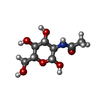
| #3: Polysaccharide | beta-D-mannopyranose-(1-4)-2-acetamido-2-deoxy-beta-D-glucopyranose-(1-4)-2-acetamido-2-deoxy-beta- ...beta-D-mannopyranose-(1-4)-2-acetamido-2-deoxy-beta-D-glucopyranose-(1-4)-2-acetamido-2-deoxy-beta-D-glucopyranose Source method: isolated from a genetically manipulated source #4: Polysaccharide | 2-acetamido-2-deoxy-beta-D-glucopyranose-(1-4)-2-acetamido-2-deoxy-beta-D-glucopyranose | Source method: isolated from a genetically manipulated source #5: Polysaccharide | 2-acetamido-2-deoxy-beta-D-glucopyranose-(1-3)-2-acetamido-2-deoxy-beta-D-glucopyranose | Source method: isolated from a genetically manipulated source #6: Sugar | ChemComp-NAG / | |
|---|
-Details
| Has ligand of interest | Y |
|---|---|
| Has protein modification | Y |
| Sequence details | The first 16 residues of chain A, B, and E (MPLLLLLPLL |
-Experimental details
-Experiment
| Experiment | Method: ELECTRON MICROSCOPY |
|---|---|
| EM experiment | Aggregation state: PARTICLE / 3D reconstruction method: single particle reconstruction |
- Sample preparation
Sample preparation
| Component | Name: L-TGF-beta1 in complex with its anchor protein LRRC33 / Type: COMPLEX / Entity ID: #1-#2 / Source: RECOMBINANT |
|---|---|
| Molecular weight | Value: 0.15 MDa / Experimental value: NO |
| Source (natural) | Organism:  Homo sapiens (human) Homo sapiens (human) |
| Source (recombinant) | Organism:  Homo sapiens (human) / Cell: HEK293 Homo sapiens (human) / Cell: HEK293 |
| Buffer solution | pH: 7.5 |
| Specimen | Conc.: 3 mg/ml / Embedding applied: NO / Shadowing applied: NO / Staining applied: NO / Vitrification applied: YES |
| Specimen support | Grid material: GOLD / Grid mesh size: 400 divisions/in. / Grid type: Quantifoil R1.2/1.3 |
| Vitrification | Cryogen name: ETHANE |
- Electron microscopy imaging
Electron microscopy imaging
| Experimental equipment |  Model: Titan Krios / Image courtesy: FEI Company |
|---|---|
| Microscopy | Model: FEI TITAN KRIOS |
| Electron gun | Electron source:  FIELD EMISSION GUN / Accelerating voltage: 300 kV / Illumination mode: FLOOD BEAM FIELD EMISSION GUN / Accelerating voltage: 300 kV / Illumination mode: FLOOD BEAM |
| Electron lens | Mode: BRIGHT FIELD / Nominal defocus max: 1200 nm / Nominal defocus min: 800 nm |
| Image recording | Electron dose: 60 e/Å2 / Detector mode: SUPER-RESOLUTION / Film or detector model: GATAN K2 SUMMIT (4k x 4k) |
- Processing
Processing
| EM software | Name: SerialEM / Category: image acquisition |
|---|---|
| CTF correction | Type: NONE |
| 3D reconstruction | Resolution: 4.01 Å / Resolution method: FSC 0.143 CUT-OFF / Num. of particles: 254673 / Symmetry type: POINT |
| Atomic model building | Protocol: OTHER |
 Movie
Movie Controller
Controller





 PDBj
PDBj